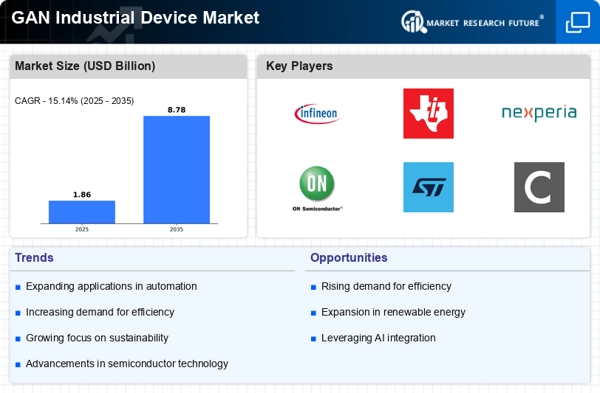Advancements in Telecommunications
The telecommunications sector is undergoing a transformation, driven by the rollout of 5G technology, which is significantly influencing the GAN Industrial Device Market. GaN devices are essential for the development of high-frequency amplifiers and power management systems that support 5G infrastructure. As telecom operators invest heavily in upgrading their networks, the demand for GaN technology is expected to rise. Industry forecasts suggest that the 5G market could exceed 700 billion by 2026, creating a fertile ground for GaN applications. This trend indicates that the GAN Industrial Device Market will likely experience substantial growth as telecommunications companies seek to enhance network performance and efficiency.
Rising Demand for Energy Efficiency
The increasing emphasis on energy efficiency is a pivotal driver for the GAN Industrial Device Market. As industries strive to reduce operational costs and minimize environmental impact, the adoption of Gallium Nitride (GaN) devices is becoming more prevalent. These devices are known for their superior efficiency compared to traditional silicon-based technologies. Reports indicate that GaN devices can achieve energy savings of up to 30%, which is particularly appealing in sectors such as automotive and industrial automation. This trend is likely to accelerate as regulatory frameworks tighten around energy consumption, compelling manufacturers to seek innovative solutions. Consequently, the GAN Industrial Device Market is poised for growth as companies invest in advanced technologies that promise both performance and sustainability.
Expansion of Electric Vehicle Market
The rapid expansion of the electric vehicle (EV) market serves as a significant catalyst for the GAN Industrial Device Market. With the global push towards electrification, the demand for efficient power electronics is surging. GaN devices are increasingly utilized in EV charging systems and power converters due to their ability to handle high voltages and frequencies while maintaining compact sizes. Market analysis suggests that the EV sector could reach a valuation of over 800 billion by 2027, thereby creating substantial opportunities for GaN technology. This growth trajectory indicates a robust future for the GAN Industrial Device Market, as manufacturers align their product offerings with the evolving needs of the automotive sector.
Growing Adoption of Smart Technologies
The proliferation of smart technologies across various sectors is driving demand within the GAN Industrial Device Market. As industries adopt automation and IoT solutions, the need for efficient power management systems becomes paramount. GaN devices are well-suited for these applications due to their high efficiency and compact form factor. The smart technology market is projected to grow significantly, with estimates suggesting it could reach 1 trillion by 2025. This growth is likely to spur further innovation in the GAN Industrial Device Market, as manufacturers develop new products that cater to the evolving needs of smart applications, thereby enhancing overall system performance.
Increased Investment in Renewable Energy
The GAN Industrial Device Industry. As countries aim to meet ambitious climate goals, investments in solar, wind, and other renewable technologies are escalating. GaN devices play a vital role in optimizing power conversion and management in renewable energy systems, enhancing overall efficiency. Reports indicate that the renewable energy market could surpass 2 trillion by 2030, which presents a significant opportunity for GaN technology. This increasing focus on sustainable energy solutions suggests that the GAN Industrial Device Market will benefit from heightened demand as industries seek to integrate advanced technologies into their renewable energy initiatives.















Leave a Comment